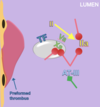Haemostasis and Thrombosis Flashcards
What percentage of Total Blood volume is Red Blood Cells?
45%
What are the two functional types of Plasma Clotting Factors?
Procoagulants
Anticoagulants
Name the main Procoadulant factors:
Fibrinogen - I
Prothrombin - II
Factors V, VII-XIII
Name the main Anticoagulant factors:
Plasminogen
TFPI - Tissue factor pathway inhibitor
Proteins C & S
Antithrombin
What is Haemostasis?
Physiological process that causes blood coagulation to prevent excessive blood loss
What is Thrombosis?
A Pathophysiological process where a blood clot forms within a blood vessel and obstructs blood flow
What are Red Thrombi?
Venous thromboses - contains lots of erythrocytes and fibrin
What are White Thrombi?
Arterial thromboses - higher platelet component
They are white becuase of macrophages entering the lesion and becoming foam cells
When does a clot become life-threatening?
If it dislodges from the vessel and embolises
What is Virchow’s triad?
Three explanations for increased probability of Thrombus formation:
Rate of Blood Flow
Consistency of Blood
Blood Vessel Wall Integrity
How can rate of blood flow lead to formation of a clot?
Slow blood flow increases likelihood of thrombosis especially in the leg because blood pressure is low here
How can the consistency of blood affect the likelihood of a clot forming?
The balance between procoagulants and anticoagulants can change (especially in genetic conditions) and increase the chance - e.g. more pros and less antis
How can Blood vessel wall integrity affect the likelihood of a clot forming?
Injury of the blood vessel wall (tunica intima) will expose prothrombotic subendothelial structures, which increase the likelihood of thrombi forming
What are the three stages of Coagulation?
Initiation
Amplification
Propagation
What are the three drug classes that target different stages of coagulation?
Initiation - Anticoagulants
Amplification - Antiplatelets
Propagation - Thrombolytics







